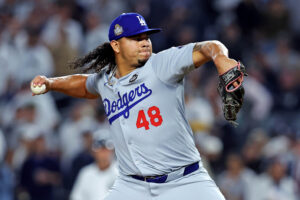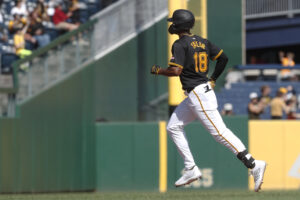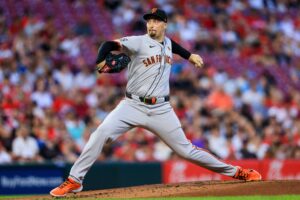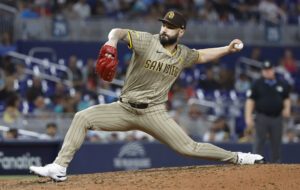Ed Ott, catcher for the Pittsburgh Pirates team that won the 1979 World Series, passed away on Sunday. He was 72. It’s been a bad week for former Pirates and even their spouses. From 1974-81 with the Pirates and California Angels, Ott batted .259/.311/.368, 33 HR, and 195 RBI. Ott was known as much for his participation in several baseball brawls as he was for his play on the diamond.
We are saddened today by the passing of Ed Ott.
A beloved member of the Pirates family, Ed spent seven of his eight years in the Major Leagues with the Pirates and was a valued member of our World Series Championship team in 1979.
Our sincere condolences to his wife, Sue,… pic.twitter.com/b3tN0ON66u
— Pittsburgh Pirates (@Pirates) March 3, 2024
Former Pirates Catcher Ed Ott Passes Away at 72
The left-handed hitting Ed Ott was drafted by the Pirates in the 23rd round of the 1970 June Amateur Draft. Ott began his minor league career as a rifle-armed right fielder who the Pirates eventually converted to a catcher. It was a wise move, with Willie Stargell, Al Oliver, Dave Parker, Richie Zisk, and Gene Clines patrolling the outfield for the big club, and Omar Moreno and Tony Armas on their way up. Ott made the majors for good in 1976 as a seldom-used third-string catcher behind Manny Sanguillén and Duffy Dyer.
After the 1976 season, the Pirates traded Sanguillén to the Oakland Athletics for manager Chuck Tanner. Dyer was ticketed to be the starting catcher for the 1977 season. However, after four games, the light-hitting Dyer was 3-for-12. Ott started the fifth game against the Montreal Expos and from then on, Ott and Dyer were a platoon combo. As the left-handed half of the tandem, Ott saw most of the action at catcher for the Pirates.
“I’ll Come and Get You”
Naturally, Pirates fans missed the popular Sanguillèn. If they hadn’t warmed up to Ott yet, they were all in on July 8, 1977. The rival Philadelphia Phillies were in Three Rivers Stadium to begin a series with the Pirates, with Ott as catcher. In the seventh inning, Pirates pitcher Bruce Kison hit Phillies star slugger Mike Schmidt with an inside pitch. There was no apparent reason to be throwing at Schmidt in that situation. But Kison had a reputation as a guy who threw at batters and Schmidt had just been hit by a pitch for the third time in four games.
As Schmidt walked to first base, he pointed angrily at Kison and said, “Next time that happens, I’ll come and get you!” Kison stepped toward him and replied, “Why wait till next time?” Schmidt then spiked his batting helmet and charged Kison. After they mixed it up with a few blows, Ott, a former high school wrestler, charged Schmidt, slammed him to the turf, and pinned him there until cooler heads prevailed. When Schmidt finally got up, his face was as red as the Phillies’ logo. The incident fired up the Pirates, who scored four in the eighth and one in the ninth to win, 8-7.
Upside Down
It wasn’t long before Ott was fighting again. It was on August 12 in the second game of a doubleheader against the New York Mets at Three Rivers. In the seventh inning, Ott slid hard into Mets second baseman Félix Millán to break up a double play. Millán objected to Ott’s slide and hit him on the side of the face with the ball in his hand. Furious, Ott lifted the 172-pound Millán by his upper leg, turned him upside down, and slammed him to the turf, breaking Millán’s collarbone. Both combatants were ejected, although the umpires and even Millán’s teammates saw nothing wrong with Ott’s slide. The Pirates won this one in twelve innings, 6-5. Millán never played in the majors again.
Clutch Hits
The Pirates were locked in a tight race with the rival Phillies in 1978. Ott had gotten hot with the bat, raising his average from .236 on August 10 to .269 in the end. Eventually, Ott became the Pirates’ everyday catcher, batting fifth behind Stargell. The Pirates closed the season with a four-game series at home against the Phillies. They also happened to be four games behind the first-place Phillies, needing a four-game sweep to force a one-game playoff.
In the opening game of the series, which was also the first game of a Friday night doubleheader, the teams were tied 4-4 going to the bottom of the ninth. Ott led off with a pop fly into right-center field. Garry Maddox and Bake McBride converged on the ball, then peeled away, allowing it to drop. Hustling all the way, Ott made it into third for a triple. Maddox’s throw went into the Phillies’ dugout, allowing Ott to score the winning run.
In 1979, Ott was again platooning at catcher for the Pirates, now with rookie Steve Nicosia. En route to a World Series championship, Ott slashed .273/.314/.385 with 7 HR and 51 RBI. His finest moment came on August 11 in Philadelphia’s Veterans Stadium, when the Pirates came back from an early 8-0 deficit to win, 14-11. On that day, Ott was 4-for-5 with 5 RBI. In the top of the eighth, Ott came to bat with the bases loaded and two outs against left-handed screwball specialist Tug McGraw. Rather than counter with Nicosia, Tanner allowed Ott to bat. Tanner never minded left-handed batters against McGraw, feeling they took away the screwball. Ott rewarded Tanner’s faith with a grand slam that caromed violently off the right field façade.
The Hook Slide
In the 1979 World Series against the Baltimore Orioles, Ott was 4-for-12 with 3 RBI. With Baltimore starting left-handers in four games, Nicosia saw most of the action behind the dish. Lost among Stargell’s MVP performance was Ott’s main contribution in the Series, in Game Two at Baltimore’s Memorial Stadium. With the score tied 2-2 in the top of the ninth, Ott hit a two-out infield single against Don Stanhouse. After Phil Garner walked, advancing Ott to second, pinch hitter Sanguillén (reacquired in 1978) lined a single to right field. Eddie Murray sent a strong relay throw home. However, Ott’s brilliant hook slide got around catcher Rick Dempsey’s tag. The 3-2 lead held up when Kent Tekulve retired the Orioles in order.
Pirates Trade Ott
In the spring of 1981, with prospect catcher Tony Peña deemed ready, the Pirates traded Ott to the California Angels in a controversial deal for first baseman Jason Thompson. The Pirates had pre-arranged for Thompson to be immediately flipped to the New York Yankees for first baseman Jim Spencer and cash – a lot of it. Pirates fans were outraged that their favorite team would even think of trading Thompson for Spencer. General manager Hardy Peterson explained that Spencer hit left-handed pitching better and fielded better, while Thompson typically hit to the deepest part of the ballpark. However, as was his wont, Commissioner Bowie Kuhn vetoed the deal because of the amount of cash involved. Soon, Pirates fans discovered that Thompson couldn’t hit left-handers, fielded poorly, and hit to the deepest part of the ballpark.
Still Fighting
Meanwhile, with the Angels, Ott was at the center of three bench-clearing brawls with the Oakland Athletics. Oakland’s fiery manager Billy Martin singled out Ott as an instigator of each of the altercations. On one occasion, Ott objected to Rickey Henderson and Shooty Babitt answering questions that were intended for the umpire. On another, Martin didn’t like Ott’s aggressiveness in blocking home on a suicide squeeze play. There is no record of Ott employing his wrestling moves on any of these occasions. However, it’s easy to imagine he wasn’t a mere spectator.
A torn rotator cuff ended Ott’s major league career after the 1981 season when he was just 29 years old. He joined the Houston Astros as a coach from 1989-93. On April 11, 1991, benches cleared when Cincinnati Reds pitcher Rob Dibble threw a pitch behind Houston’s Eric Yelding. Soon Dibble was at the bottom of a pile of players in a choke hold, courtesy of – you guessed it – coach Ott, a fighter to the end.
Photo Credit: Aaron Doster-USA TODAY Sports






